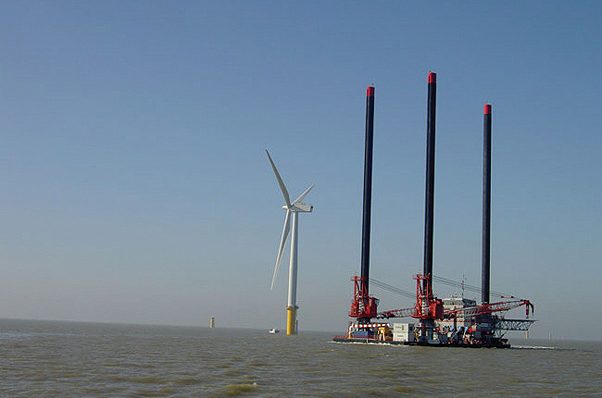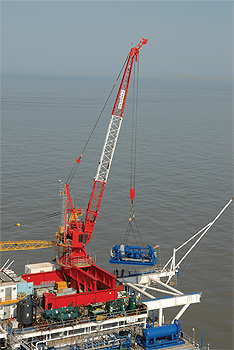
Seatrax UK
Raising its game
Firmly positioned at the forefront of deepwater lifting, Seatrax UK Ltd covers all the offshore lifting requirements in the world’s oil, gas and marine industries with its proven range of API 2C ‘Kingpost’ cranes.
Utilised on all offshore and marine installations around the globe, Seatrax cranes are widely recognised for their operational safety, robust design, and ease of maintenance and lifetime cost-effectiveness.
 The company’s location in Great Yarmouth, in the southeast of England, gives direct access to the North Sea and international waterways, with load-out of the completed machines being either by water, directly over its 175 metre quay heading on the River Yare, or by road.
The company’s location in Great Yarmouth, in the southeast of England, gives direct access to the North Sea and international waterways, with load-out of the completed machines being either by water, directly over its 175 metre quay heading on the River Yare, or by road.
“The principals of Seatrax have been designing and manufacturing API 2C ‘Kingpost’ cranes for over 35 years from its world headquarters in Houston, Texas,” reveals Seatrax’ UK’s sales & marketing director, Graham Manning. “Here in Great Yarmouth, we’ve been operating since 1996 as a wholly owned subsidiary of Seatrax Inc with a current workforce of approximately 70 people and have been steadily building a broad customer base in many of the world’s oil and gas theatres.”
Seatrax has remained at the forefront in the supply of ‘kingpost’ type cranes for many years by providing inherent crane safety through design and not through the dependence of gadgets. During that time it has established a great deal of patents for its designs. As such, all cranes are covered by third party certification, with those destined for North Sea or European customers having appropriate regulatory compliance and ‘CE’ marking in accordance with the European Machinery Directive.
Graham continues: “In 2004 the international crane specification API 2C was revised from the 5th Edition to the 6th Edition, which incorporated significant design changes, in particular for cranes mounted on floating applications, while tightening up other mandatory requirements to provide safer cranes for offshore applications. Further enhancing API 2C’s reputation as the primary crane specification for the worldwide oil and gas industry. In conjunction with the release of the 6th Edition specification, Seatrax actively set about enhancing its already very successful product line, while ensuring that the decades of industry proven safety and reliability attributes continued into the future.
“Currently, API 2C is under further revision and is expected to be in force by the end of 2010, which again will have significant changes to mandatory design requirements, presenting a new challenge for all suppliers of offshore pedestal cranes. So once again, we look forward to raising our game in making any required product changes to comply with the 7th Edition. In doing so we believe we will remain at the forefront of offshore crane design and will continue to provide our customers with state-of-the-art equipment.”
Seatrax’ ‘kingpost’ design is one of its key strengths, due to the fact that once installed it becomes an integral part of the host supporting structure. Unlike the conventional bolted slew bearing assembly type cranes this type of connection has never failed due to gross overload through vessel entanglement.
Considering what else Seatrax has to offer, Graham asserts: “Customer focus, flexibility, high product quality and our hard earned experience – all contribute to our success. Our cranes have been  installed on all types of facilities and applications, including fixed platforms, jack-ups, drillships, FPSOs, pipelay or heavy lift barges and semi-submersibles, that has provided us with a wealth of invaluable experience.
installed on all types of facilities and applications, including fixed platforms, jack-ups, drillships, FPSOs, pipelay or heavy lift barges and semi-submersibles, that has provided us with a wealth of invaluable experience.
“Unlike some cranes in the market that are complicated to operate and maintain our product is based upon an extremely good and reliable design principal, therefore providing simple, safe and cost effective crane ownership that is uncomplicated to operate and maintain.”
Graham explains why reliability and safety is central to what Seatrax offers: “We believe our crane is the safest form of offshore crane mount as it is welded directly to the supporting structures pedestal, whereas many other types of crane have a ring of bolts that attach the crane to the pedestal – which, if subject to a gross overload condition can see a catastrophic failure. Our design eliminates this most critical point of failure along with downstream slew bearing repair and/or replacement – which is very expensive and time consuming.”
Seatrax has also recently introduced a range of portable offshore rental cranes that can be configured with a range of optional equipment to meet a customer’s specific needs. “Our full portable rental fleet came on stream last year,” says Graham. “All of our rental cranes are newly built and we now have four models within the range, these are: the Model 70P with a maximum component weight of eight tonnes, the Model 90P with a maximum component weight of nine tonnes, the Model S140P with a maximum component weight of 12 tonnes and the Model S230P – offering working radii of up to 52 metres and offboard capacities of up-to 100 tonnes and a maximum component weight of 15 tonnes.
“Within the offshore industry there are a number of portable cranes that can be anything up to 30 years old and are not built to any recognised specification,” he continues. “Seatrax decided to take a completely different approach and produce a rental fleet that met and exceeded all necessary requirements mandated by API 2C 6th Edition (including Personnel Handling), while maintaining our marine crane standards. This approach provides our customers with the confidence that they have safe and reliable equipment employed on their projects.”
The primary applications for Seatrax’ portable rental cranes comprise of decommissioning, compressor upgrade/replacement, general construction, pipeline installation/removal, derrick building, remedial well services support, plug and abandonment, platform salvage, diving support and crane removal/installation.
“With regard to the UK’s rental fleet, we have reviewed the number of platforms to be decommissioned in this region in the years to come and strongly believe that our portable cranes have a great deal to offer with respect to plug and abandonment and initial decommissioning activities,” says Graham. “As such we are in the process of increasing our rental assets for what we see as an expanding market.”
Looking to the future, Graham shares his thoughts on the coming years: “While we are presently working through our back-log of orders, from an order placement point of view we had a quiet 2009. But saying that, since the 4th Quarter 2009, we have experienced a significant upturn in tendering activities and as a result remain optimistic that a large number of projects will be given the ‘go ahead’ in 2010 in support of new build cranes for the next few years and we project continual growth in our portable crane rental business.”
Seatrax UK
Products: Cranes